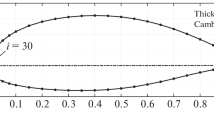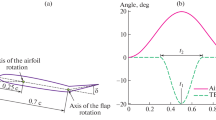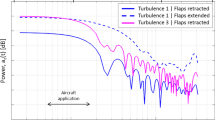Abstract
The ability of artificial neural networks (ANN) to model the unsteady aerodynamic force coefficients of flapping motion kinematics has been studied. A neural networks model was developed based on multi-layer perception (MLP) networks and the Levenberg–Marquardt optimization algorithm. The flapping kinematics data were divided into two groups for the training and the prediction test of the ANN model. The training phase led to a very satisfactory calibration of the ANN model. The attempt to predict aerodynamic forces both the lift coefficient and drag coefficient showed that the ANN model is able to simulate the unsteady flapping motion kinematics and its corresponding aerodynamic forces. The shape of the simulated force coefficients was found to be similar to that of the numerical results. These encouraging results make it possible to consider interesting and new prospects for the modelling of flapping motion systems, which are highly non-linear systems.









Similar content being viewed by others
References
Madangopal R, Khan ZA, Agrawal SK (2005) Biologically inspired design of small flapping wing air vehicles using four-bar mechanisms and quasi-steady aerodynamics. J Mech Des 127:809–816
Platzer MF, Jones KD (2006) Flapping wing aerodynamics—progress and challenges. AIAA-2006-0500, Reno, Nevada
Deng X, Schenato L, Wu WC, Sastry S (2006) Flapping flight for biomimetic robotic insects: part I-system modelling. IEEE Trans Rob 22:776–788
Sane SP, Dickinson MH (2002) The aerodynamic effects of wing rotation and a revised quasi-steady model of flapping flight. J Exp Biol 205:1087–1096
Kurtulus DF, Farcy A, Alemdaroglu N (2005) Unsteady aerodynamics of flapping airfoil in hovering flight at low reynolds numbers. AIAA-2005-1356, Reno, Nevada
Ansari SA, Zbikowski R, Knowles K (2006) Aerodynamic modelling of insect-like flapping flight for micro air vehicles. Prog Aerosp Sci 42:129–172
Narendra KS, Parthasaranthy K (1990) Identification and control of dynamical systems using neural networks. IEEE Trans Neural Netw 1(1):4–27
Hunt K J, Sbarbaro D, Zbikowski R, Gawthrop PJ (1992) Neural networks for control systems—a survey. Automatica 28(6):1083–1112
Calise AJ, Rysdyk RT (1998) Nonlinear adaptive flight control using neural networks. IEEE Control Syst Mag NY 18(6):14–25
Linse D, Stengel RF (1993) Identification of aerodynamic coefficients using computational neural networks. J Guid Control Dyn 16(6):1018–1025
Wu HY, Zhou ZY, Sun D (2003) Autonomous hovering control and test for micro air vehicle. In: Proceedings of the 2003 IEEE international conference on robotics & automation, vol 1, pp 528–533
Milano M, Gharib M (2005) Uncovering the physics of flapping flat plates with artificial evolution. J Fluid Mech 534:403–409
Rakotomamonjy T, Ouladsine M, Le Moing T (2007) Modelization and kinematics optimization for a flapping-wing microair vehicle. J Aircr 44:217–231
Dickinson MH, Lehmann FO, Sane SP (1999) Wing rotation and the aerodynamic basis of insect flight. Science 284:1954–1960
Skapura DM (1996) Building neural networks. Addison–Wesley, Menlo Park
Hagan MT, Menhaj MB (1994) Training feed-forward neural networks with the Marquardt algorithm. IEEE Trans Neural Netw 5:989–993
Parisi R, Di Claudio ED, Orlandi G, Rao BD (1996) A generalized learning paradigm exploiting the structure of feedforward neural networks. IEEE Trans Neural Netw 7:1450–1459
Yu X, Efee MO, Kaynak O (2002) A general backpropagation algorithm for feed-forward neural networks learning. IEEE Trans Neural Netw 13(1):251–254
Demuth H, Beale M (1993) Neural network toolbox for use with Matlab. The Mathworks Inc
Haykin S (1999) Neural networks a comprehensive foundation. 2nd edn. Prentice-Hall, Upper Saddle River
Kurtulus DF, David L, Farcy A, Alemdaroglu N (2008) Aerodynamic characteristics of flapping motion in hover. Exp Fluids 44:23–36
Akay B, Kurtulus DF, Alemdaroglu N (2007) Unsteady aerodynamics of different wing profiles at low reynolds number. NATO AVT-146 symposium on platform innovations and system integration for unmanned air, land and sea vehicles, 14–17 May 2007, Florence
Schalkoff RJ (1997) Artificial neural networks. McGraw-Hill, NY
Dickinson MH, Götz KG (1993) Unsteady aerodynamic performance of model wings at low Reynolds number. J Exp Biol 174:45–64
Wang JZ, Birch JM, Dickinson MH (2004) Unsteady forces and flows in low Reynolds number hovering flight: two-dimensional computations vs robotic wing experiments. J Exp Biol 207:449–460
Poelma C, Dickson WB, Dickinson MH (2006) Time-resolved reconstruction of the full velocity field around a dynamically-scaled flapping wing. Exp Fluids 41:213–225
Singh B, Ramasamy M, Chopra I, Leishman GJ (2005) Experimental studies on insect-based flapping wings for micro hovering air vehicles. 46th annual structural dynamics and materials conference 18–20 April 2005, Austin, TX
Acknowledgments
The authors acknowledge the supports by ENSMA, METU, TUBITAK, CNRS and French Embassy in Turkey.
Author information
Authors and Affiliations
Corresponding author
Rights and permissions
About this article
Cite this article
Kurtulus, D.F. Ability to forecast unsteady aerodynamic forces of flapping airfoils by artificial neural network. Neural Comput & Applic 18, 359–368 (2009). https://doi.org/10.1007/s00521-008-0186-2
Received:
Accepted:
Published:
Issue Date:
DOI: https://doi.org/10.1007/s00521-008-0186-2




